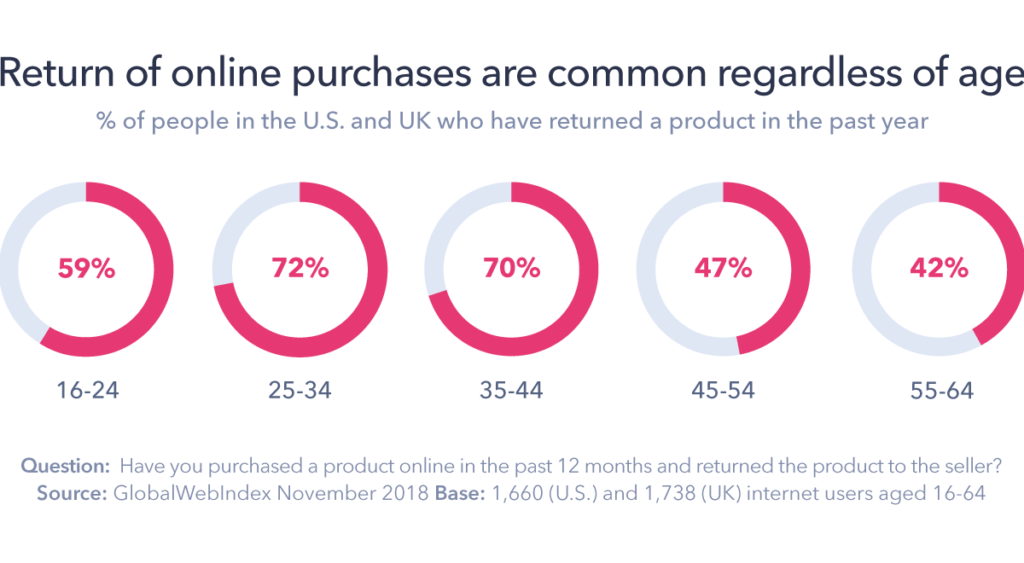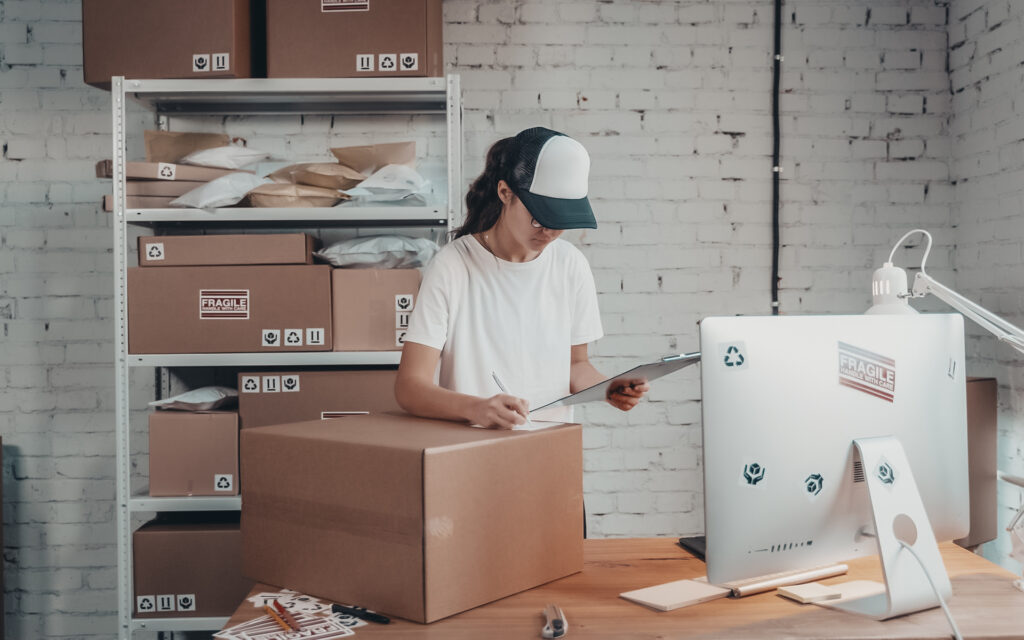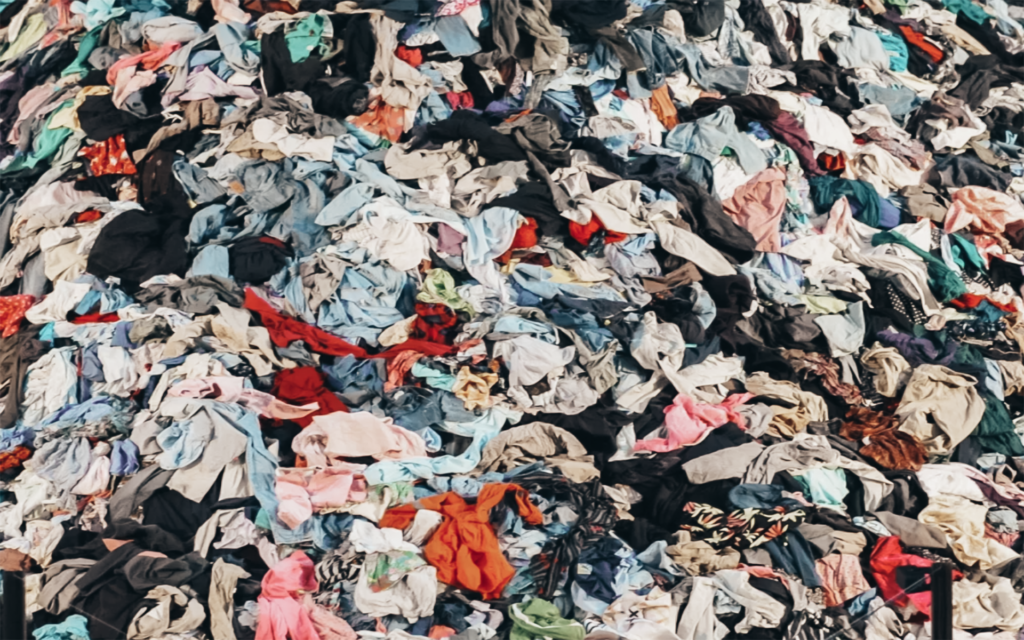Online shopping has made it easier for people to shop anytime and anywhere. People can now purchase items, try them on, and return whatever they don’t see fit. Indeed, this has made lives more accessible, but it has detrimental effects on our environment.
According to the Global Web Index, people between the ages of 25-44 have returned items they purchased over a year by approximately 70%. 80% of people from the UK and USA check return policies on retailers’ websites before buying. It is important to note that return policies are essential for consumers when considering any purchase online. To stay competitive in e-commerce, online shops have made returns in fashion part of the main elements to ensure purchases.

Costs and impacts on companies
40% of products returned are clothing items. This has an impact on companies issuing these deliveries. From the expense of restocking to the possibility of reprocessing, companies are looking for new ways to reduce the number of returns. When buying products online, people miss the “real feel” and quality of clothing and there are sizing issues that lead to a high number of returns.
Retailers have called returns a “logistical nightmare” where managing the logistics and transport is not the only issue but also cleaning and repackaging. According to the National Retail Federation in the USA, it was expected that 761 billion dollars worth of clothing would return to retailers in 2021. Retailers suffer from approximately 166 million dollars in returns for every 1 billion dollars in sales.
What are the costs that retailers suffer when returns occur?
- Packaging
- Sorting
- Shipping
- Processing

Alternatives to returns in fashion
With this issue being gravely costly and not environmentally friendly, retailers are seeking alternatives that can reduce side effects.
Possible solutions can be:
- Return fees
- Adding more UGC (User-Generated-Content)
- Peer-to-Peer Returns
Return Fees
Stores selling fast fashion are the most purchased from online and they are starting to implement fees on returns. Zara is now charging for returns in the UK and other markets, which resulted in no effect on sales. 69% of UK online shoppers showed a positive insight on the implemented fee stating,
they would be willing to pay for returns as long as the money is used to reduce their environmental impact.
ReBound
Adding more UGC (User-Generated-Content)
Giving consumers access to how an item can look on them in real life could be the most effective way to reduce returns. A new tech-developed “try-on” method is being adopted by online shops, which enables consumers to get a sense of reality on sizing and more through augmented reality tools. Approximately 60% of consumers stated that adding post-purchase content and utilizing “try-on” tech will reduce returns over time.
Peer-to-Peer Returns
Any unwanted items consumers wish to return are sent directly to another customer interested in purchasing that item. This relieves the consumer from paying a return fee and the retailer from receiving any items back. Here, the retailer takes care of the shipping process and provides the shipping label. This is less costly for the retailer because they wouldn’t need to go through a reverse logistics process, which is very expensive. This works when customers want to return high-demand items, but not when it’s large or bulk returns.

Why does a large percentage of returns go to landfills?
People might think that returns end up in the stores again, but that is rarely the case. Reverse logistics has resulted in the accumulation of 5 billion pounds of waste, which end up in landfills yearly. When items are shipped and returned several times over time, they are most likely to end up in landfills, often in different countries and continents. Sarah Needham, Centre for Sustainable Fashion at the University of the Arts London, stated that
We know that many of the products that are returned end up in landfill before we even use them which only adds to the vast amounts of used items already ending up in landfill… These products use precious resources which are becoming scarce and we are throwing them away unnecessarily.
BBC Earth
She emphasizes that the flow of goods and how they are being dealt with is tarnished economically and environmentally. Some companies don’t have the resources and space to ethically find a more sustainable solution for returned goods and turn to dumping them in landfills.

What is Wardrobing?
With the return policy, some consumers purchase items, wear them and then return them. The concept of wardrobing was created ever since the return policy got implemented. Approximately 40% of customers have admitted to wardrobing.
Why do they do it?
- As an initial test, customers wear items to see if it fits their needs
- Returning items to regain the money they spent after wearing them
- The need for a one occasion dress or suit
- For social purposes, and struggle to keep up with new trends and the fear of wearing the same item more than once
- The thrill of getting away with a “victimless” crime
Customers might think that this does not damage retailers, but worn items loose value due to possible stains and odors, which lead to the inability to resell the item for its retail value. Also, returning items after their season has already passed, forces retailers to sell them at a discounted price because they’re considered “out-of-season.”
How to prevent it?
- Develop a concise return policy detailing strict requirements of returns
- Strengthen inspection of returned items in the reverse logistics process
- Using anti-wardrobing tags that are difficult to camouflage preventing people from wearing items
- Blacklisting wardrobers
What is the solution for returns in fashion?
Reducing the number of returns is the goal for many retailers, and to do that, they must follow guidelines when displaying products online.
To name a few:
- Give customers as much information as you can on fabric quality and measurements. With new technologies emerging, it has become easier for retailers to give rough sizing to customers, which will decrease the number of returns due to inaccurate sizing;
- Give instructions on how body measurements should be taken to diminish confusion;
- Using enhanced imagery of products with access to view from different vantage points gives the customer access to how the product will look in real life. One of the issues this tackles is managing the expectations of customers;
- Encourage customers to leave feedback on the sizing and quality of products, which helps present and future shoppers make a well-established decision before the purchase.
What can be done for the future?
Virtual fitting rooms are a new up-and-coming solution that manages expectations and gives customers an overview of how items will look like. This will help reduce returns majorly once enforced. Robosize is a company that has developed all-inclusive high-tech 3D and AR technologies giving people access to a detailed view similar to that you get in-store.






